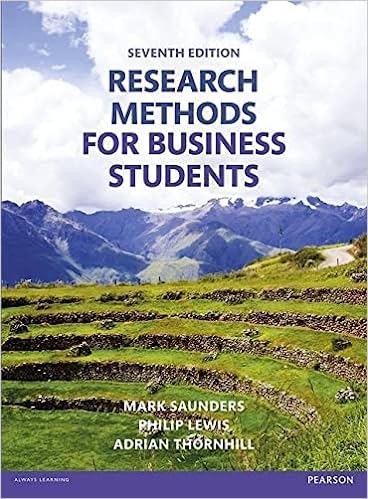Andrew, a final year part-time MBA student employed by a large Maltese market research company, read in
Question:
Andrew, a final year part-time MBA student employed by a large Maltese market research company, read in a local newspaper that Malta (a small island state situated in the centre of the Mediterranean Sea) has the highest rate of economically inactive women in the European Union.
‘Inactivity’ is a term that refers to all persons who are not classified as employed or unemployed (Eurostat 2011). This category includes students, retired persons, home makers, and ill or permanently disabled persons. On investigating further, he discovered that inactive women in Malta account for 52.2 per cent of the population of females in the working age group (16 to 64 years), while the female homemakers group represent the single largest dominant group (76.6 per cent)
among the inactive population in Malta (Eurostat 2012).
Andrew was curious about these statistics and decided to conduct a study with Maltese inactive female homemakers for his research project. More specifically, he wanted to understand what motivated and what hindered them in seeking paid employment so as to determine which types of policies could facilitate their entry or re-entry into the labour market.
In determining the sample size for the study, Andrew specified a level of confidence in the estimate(s) of 95 per cent (this corresponding to a z score of 1.96) and a margin of error of 5 per cent. Without a pilot study, he assumed a worst-case scenario and hence a response rate of 50 per cent for categorical variables (De Vaus 2014 and Appendix 2). As the total population of female homemakers was 63,290 (Eurostat 2012), the minimum sample size needed to be 383.
Andrew wanted a random sample (i.e. one based on chance) and so all the female homemakers in the sampling frame had to have an equal chance of receiving an invitation.
Additionally, to eliminate the threat of loss of participants, he wanted to find random replacements for all the initial invitees who for some reason or other declined to participate in the study. He was aware that his organisation was in possession of a sampling frame of inactive female homemakers, and that this was based on the information gathered during the most recent census carried out in the Maltese Islands. He therefore enquired about the possibility of being provided with a random sample of Maltese inactive female homemakers aged 16–64 whom he could then contact to collect his data. Their initial answer did not appear helpful! His employer was not in a position to provide the list since these inactive persons represent a vulnerable group. Andrew was worried as he did not want to resort to nonprobability sampling methods. He believed that if a truly random process was used to select the sample from the population, the resulting sample would be like a miniature replica of the population – one that looks just like the population but smaller. Andrew therefore decided to ask if his employer would distribute a questionnaire on his behalf. Again the answer was no!
Fortunately his employer was interested in finding out more about Maltese inactive female homemakers, and so suggested an alternative method with the following terms of reference:
a The target population consisted of inactive female homemakers aged between 16 and 64 years.
b His employer would randomly select 400 female homemakers from their sampling frame.
To account for potential non-responses, random replacements would be found for any of the initial invitees who for some reason or another declined to participate in the research.
Additionally, if any of the originally selected female homemakers had reached the retirement age (65+), started working, registered themselves as students, or became ill or permanently disabled during the time of study, they would also be replaced at random.
c The questions to be asked would be provided by Andrew, following ethical clearance from his university’s Ethics Committee. Demographic information about the respondents concerning age, marital status, highest level of education and past occupation (if any) had already been collected and were included in his employer’s sampling frame, and so there was no need to ask for such information in the telephone questionnaire.
d His employer would collect and prepare the data for statistical analysis. Andrew would receive a copy of cleaned and anonymised data in IBM SPSS Statistics format within 15 days of the end of the data collection period.
In total, his employer targeted 486 female homemakers (total number in sample). From these, 402 answered the telephone survey (total number of responses), 57 were unreachable and another 27 were ineligible to respond because at the time of the survey they were either in employment or had reached retirement age. Hence the total response rate was 87.6 per cent while the active response rate was 100 per cent.
Andrew was pleased that the sample was efficient since its size just exceeded 383 (the minimum sample size), and this meant that the sample size met the specified precision and confidence goals he aimed for. Additionally, he was confident that his sample was random and representative – that is, any numerical summaries of the gathered information would be unbiased and any statistical inferences drawn would be valid (Huck 2009). He felt that he could now proceed with the analysis of the data.
Questions 1 In what ways is the Census data likely to differ from the actual population when Andrew conducts his research?
2 Is Andrew’s random sample a miniature replica of the population? Give reasons for your answer.
3 Does the inactive female homemakers’ sample represent a random sample from the population?
Give reasons for your answer.
4 What would you recommend to minimise the impact of nonparticipation?
Step by Step Answer:

Research Methods For Business Students
ISBN: 9781292016627
7th Edition
Authors: Mark N.K. Saunders, Philip Lewis, Adrian Thornhill





